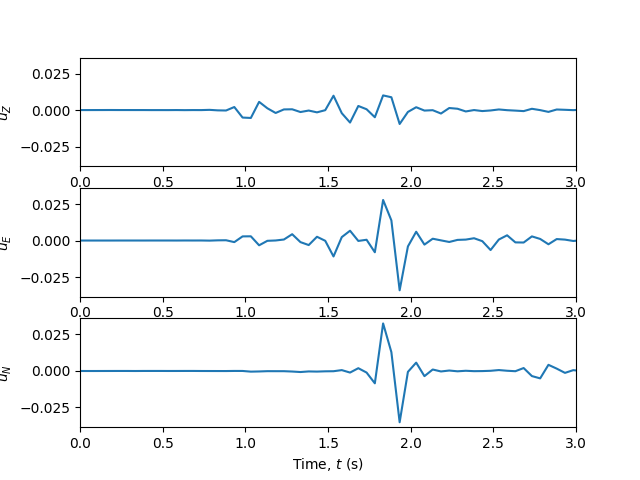Welcome to ShakerMaker’s documentation!¶
ShakerMaker is intended to provide a simple tool allowing earthquake engineers and seismologists to easily use the frequency-wavenumber method (hence FK) to produce ground-motion datasets for analysis using the Domain Reduction Method (DRM). DRM motions are stored directly into the H5DRM format.
FK method, the core of ShakerMaker, is impemented in fortran (originally from http://www.eas.slu.edu/People/LZhu/home.html with several modifications), and interfaced with python through f2py wrappers. Classes are built on top of this wrapper to simplify common modeling tasks such as crustal model specification, generation of source faults (from simple point sources to full kinematic rupture specifications), generating single recording stations, grids and other arrays of recording stations and stations arranged to meet the requirements of the DRM. Filtering and simple plotting tools are provided to ease model setup. Finally, computation of motion traces is done by pairing all sources and all receivers, which is parallelized using MPI. This means that ShakerMaker can run on simple personal computers all the way up to large supercomputing clusters.
Contents
Dependencies¶
We stand on the shoulder’s of giants. ShakerMaker depends on the following python modules (most)
to work its magic.
- mpi4py (optional but highly recommended for parallel computing of the response)
- h5py
- numpy
- scipy
- f2py
- matplotlib (optional, for plotting)
Get them all with pip:
sudo pip install mpi4py h5py numpy scipy matplotlib tqdm
Installation¶
For now, only though the git repo:
git clone git@github.com:jaabell/ShakerMaker.git
Use the setup.py script, using setuptools, to compile and install:
sudo python setup.py install
If you dont’ have sudo, you need:
sudo python setup.py install --user
Build the documenation with:
sudo python setup.py build_sphinx
Quickstart usage¶
Using ShakerMaker is simple. You need to specify a shakermaker.crustmodel (choose from the available
predefined models or create your own), a fkdrm.SourceModel (from a simple
fkdrm.Receivers.PointSource to a complex fully-customizable extended source with fkdrm.Receivers.MathyFaultPlane)
and, finally, a fkdrm.Receiver specifying a place to record motions (and store them
in memory or text format).
In this simple example, we specify a simple strike-slip (strike=30, clockwise from north) point source at the origin and a depth of 4km, on a custom two-layer crustal model, and a single receiver 5km away to the north.
Start by importing the needed components:
#./doc/examples/example_0_quick_example.py
from shakermaker.shakermaker import ShakerMaker
from shakermaker.crustmodel import CrustModel
from shakermaker.pointsource import PointSource
from shakermaker.faultsource import FaultSource
from shakermaker.station import Station
from shakermaker.stationlist import StationList
from shakermaker.tools.plotting import ZENTPlot
Create a new two-layer CrustModel:
crust = CrustModel(2)
#Slow layer
Vp=4.000 # P-wave speed (km/s)
Vs=2.000 # S-wave speed (km/s)
rho=2.600 # Density (gm/cm**3)
Qp=10000. # Q-factor for P-wave
Qs=10000. # Q-factor for S-wave
thickness = 1.0 # Self-explanatory
crust.add_layer(thickness, Vp, Vs, rho, Qp, Qs)
#Halfspace
Vp=6.000
Vs=3.464
rho=2.700
Qp=10000.
Qs=10000.
thickness = 0 #Zero thickness --> half space
crust.add_layer(thickness, Vp, Vs, rho, Qp, Qs)
Specify source location (xyz coordinates: x is north, y is east, z is down, see [Coordinate system in shakermaker]) and strike, dip and rake angles:
source = PointSource([0,0,4], [90,90,0])
fault = FaultSource([source], metadata={"name":"single-point-source"})
Specify receiver location (xyz as before):
s = Station([0,4,0],metadata={"name":"a station"})
stations = StationList([s], metadata=s.metadata)
These are fed into the FKDRM model class:
model = ShakerMaker(crust, fault, stations)
Which is executed:
model.run()
Results at the station can be readily visualized using the utility function Tools.Plotting.ZENTPlot():
ZENTPlot(s, xlim=[0,60], show=True)
This script can be executed from the command line as follows:
python3 example_0_quick_example.py
Yielding:

Response at receiver station. No source time function was specified, so this is just a Greens function (impulse response) of the medium.
Parallel computation capabilities¶
To make use of multi-processor architechtures and computer clusters, ShakerMaker is parallelized internally using mpi4py. Running a script in parallel processing mode is simply done using an mpirun call, no modifications to the script are necessary:
mpirun -np 10 python <script-name>